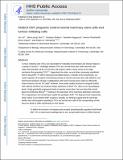| dc.contributor.author | Ye, Xin | |
| dc.contributor.author | Tam, Wai Leong | |
| dc.contributor.author | Shibue, Tsukasa | |
| dc.contributor.author | Kaygusuz, Yasemin | |
| dc.contributor.author | Ng Eaton, Elinor | |
| dc.contributor.author | Reinhardt, Ferenc | |
| dc.contributor.author | Weinberg, Robert A | |
| dc.date.accessioned | 2018-07-13T16:26:49Z | |
| dc.date.available | 2018-07-13T16:26:49Z | |
| dc.date.issued | 2015-09 | |
| dc.date.submitted | 2014-12 | |
| dc.identifier.issn | 0028-0836 | |
| dc.identifier.issn | 1476-4687 | |
| dc.identifier.uri | http://hdl.handle.net/1721.1/116979 | |
| dc.description.abstract | Tumour-initiating cells (TICs) are responsible for metastatic dissemination and clinical relapse in a variety of cancers. Analogies between TICs and normal tissue stem cells have led to the proposal that activation of the normal stem-cell program within a tissue serves as the major mechanism for generating TICs. Supporting this notion, we and others previously established that the Slug epithelial-to-mesenchymal transition-inducing transcription factor (EMT-TF), a member of the Snail family, serves as a master regulator of the gland-reconstituting activity of normal mammary stem cells, and that forced expression of Slug in collaboration with Sox9 in breast cancer cells can efficiently induce entrance into the TIC state. However, these earlier studies focused on xenograft models with cultured cell lines and involved ectopic expression of EMT-TFs, often at non-physiological levels. Using genetically engineered knock-in reporter mouse lines, here we show that normal gland-reconstituting mammary stem cells residing in the basal layer of the mammary epithelium and breast TICs originating in the luminal layer exploit the paralogous EMT-TFs Slug and Snail, respectively, which induce distinct EMT programs. Broadly, our findings suggest that the seemingly similar stem-cell programs operating in TICs and normal stem cells of the corresponding normal tissue are likely to differ significantly in their details. | en_US |
| dc.description.sponsorship | Breast Cancer Research Foundation | en_US |
| dc.description.sponsorship | Samuel Waxman Cancer Research Foundation | en_US |
| dc.description.sponsorship | Ludwig Center for Molecular Oncology at MIT | en_US |
| dc.description.sponsorship | National Cancer Institute (U.S.).(Program P01-CA080111) | en_US |
| dc.description.sponsorship | National Cancer Institute (U.S.).(Program R01-CA078461) | en_US |
| dc.description.sponsorship | National Cancer Institute (U.S.).(Program U01-CA184897) | en_US |
| dc.publisher | Springer Nature | en_US |
| dc.relation.isversionof | http://dx.doi.org/10.1038/NATURE14897 | en_US |
| dc.rights | Article is made available in accordance with the publisher's policy and may be subject to US copyright law. Please refer to the publisher's site for terms of use. | en_US |
| dc.source | PMC | en_US |
| dc.title | Distinct EMT programs control normal mammary stem cells and tumour-initiating cells | en_US |
| dc.type | Article | en_US |
| dc.identifier.citation | Ye, Xin, Wai Leong Tam, Tsukasa Shibue, Yasemin Kaygusuz, Ferenc Reinhardt, Elinor Ng Eaton, and Robert A. Weinberg. “Distinct EMT Programs Control Normal Mammary Stem Cells and Tumour-Initiating Cells.” Nature 525, no. 7568 (September 2015): 256–260. | en_US |
| dc.contributor.department | Massachusetts Institute of Technology. Department of Biology | en_US |
| dc.contributor.department | Massachusetts Institute of Technology. Division of Comparative Medicine | en_US |
| dc.contributor.mitauthor | Reinhardt, Ferenc | |
| dc.contributor.mitauthor | Weinberg, Robert A | |
| dc.relation.journal | Nature | en_US |
| dc.eprint.version | Author's final manuscript | en_US |
| dc.type.uri | http://purl.org/eprint/type/JournalArticle | en_US |
| eprint.status | http://purl.org/eprint/status/PeerReviewed | en_US |
| dc.date.updated | 2018-07-12T17:04:55Z | |
| dspace.orderedauthors | Ye, Xin; Tam, Wai Leong; Shibue, Tsukasa; Kaygusuz, Yasemin; Reinhardt, Ferenc; Ng Eaton, Elinor; Weinberg, Robert A. | en_US |
| dspace.embargo.terms | N | en_US |
| dc.identifier.orcid | https://orcid.org/0000-0002-0895-3557 | |
| mit.license | PUBLISHER_POLICY | en_US |
